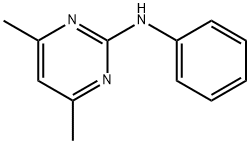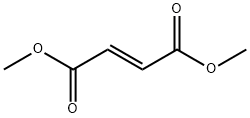Pyrimethanil
Synonym(s):2-Anilino-4,6-dimethylpyrimidine
- CAS NO.:53112-28-0
- Empirical Formula: C12H13N3
- Molecular Weight: 199.25
- MDL number: MFCD00172113
- EINECS: 414-220-3
- SAFETY DATA SHEET (SDS)
- Update Date: 2024-12-18 14:08:52

What is Pyrimethanil?
Chemical properties
Pyrimethanil is a white to light yellow crystalline powder which is sparingly soluble in water but soluble in most organic solvents. Commercial product is available as a brown emulsifiable concentrate.
The Uses of Pyrimethanil
Pyrimethanil is a broad spectrum anilino-pyrimidine foliar fungicide. Pyrimethanil functions by inhibiting the biosynthesis of methionine in Botrytis cinerea.
The Uses of Pyrimethanil
Pyrimethanil provides both protective and curative control of fungal diseases in pome fruits (leaf scab caused by Venturiu inaequalis), vines, fruits, vegetables and ornamentals (grey mould)
What are the applications of Application
Pyrimethanil is a broad spectrum anilino-pyrimidine foliar fungicide
Definition
ChEBI: Pyrimethanil is a member of the class of aminopyrimidines that is N-phenylpyrimidin-2-amine carrying two additional methyl substituents at positions 4 and 6. A fungicide used to control grey mould on fruit, vegetables and ornamentals as well as leaf scab on pome fruit. Also commonly employed to control Botrytis cinerea throughout the winemaking process in grapes, must, fermenting must and wine. It has a role as an aryl hydrocarbon receptor agonist, an environmental contaminant, a xenobiotic and an antifungal agrochemical. It is an aminopyrimidine, a secondary amino compound and an anilinopyrimidine fungicide.
Preparation
Pyrimethanil is produced by reaction of 2-bromo-4,6-dimethylpyrimidine with aniline.
Synthesis Reference(s)
Chemical and Pharmaceutical Bulletin, 30, p. 1942, 1982 DOI: 10.1248/cpb.30.1942
General Description
Pyrimethanil is an anilino-pyrimidine, broad spectrum fungicide primarily used for the control of gray mould and leaf scab on fruits, vegetables and ornamentals. Its mode of action involves inhibition of the secretion of hydrolytic enzymes by the fungi during the infection process, thus stopping the further development of the disease.
Agricultural Uses
Fungicide: Used on grapes, strawberries, tomatoes, onions, beans, cucumbers, eggplant, and ornamental.
Trade name
SCALA®; SN 100309®
Potential Exposure
A pyrimidine fungicide used on grapes, strawberries, tomatoes, onions, beans, cucumbers, eggplant, and ornamental plants.
Metabolic pathway
Limited data are available in the open literature. Information presented in this summary is abstracted from the data evaluation published by the Pesticide Safety Directorate (PSD, 1995). Hydroxylation at the methyl, phenyl or pyrimidine moiety is the primary metabolic pathway of pyrimethanil in soil, plants and animals. Cleavage of the aniho-pyrimidine linkage was observed as a minor metabolic reaction. The formation of nitro- analogues of pyrimethanil is a novel nitration reaction observed in the soil metabolism study (Scheme 1).
Shipping
UN3082 Environmentally hazardous substances, liquid, n.o.s., Hazard class: 9; Labels: 9-Miscellaneous hazardous material, Technical Name Required. UN3077 Environmentally hazardous substances, solid, n.o.s., Hazard class: 9; Labels: 9-Miscellaneous hazardous material, Technical Name Required.
Degradation
Pyrimethanil (1) is stable to hydrolytic degradation in the environmentally
relevant pH range (5-9) at 22-50 °C.
Pyrimethanil degraded rapidly at pH 4 and 30 °C (DT50 1 day) when the
sterile buffered solution was exposed to mercury arc lamp (200-500 nm).
The DT50 of pyrimethanil in pH 7 solution under the same photolysis test
conditions was ca.77 days. There is no information on the chemical nature
of pyrimethanil aqueous photolysis products.
Incompatibilities
Incompatible with oxidizers (chlorates, nitrates, peroxides, permanganates, perchlorates, chlorine, bromine, fluorine, etc.); contact may cause fires or explo- sions. Keep away from alkaline materials, strong bases, strong acids, oxoacids, epoxides.
Waste Disposal
Containers must be disposed of properly by following package label directions or by contacting your local or federal environmental control agency, or by contacting your regional EPA office. If this material cannot be disposed of according to label instruc- tions, it may be dissolved or mixed with a combustible sol- vent and burned in a chemical incinerator equipped with an afterburner and scrubber. In accordance with 40CFR165, follow recommendations for the disposal of pesticides and pesticide containers.
Properties of Pyrimethanil
| Melting point: | 96°C |
| Boiling point: | 362.8±45.0 °C(Predicted) |
| Density | 1.15 |
| vapor pressure | 2.2 x l0-5 Pa (25 °C) |
| storage temp. | Keep in dark place,Inert atmosphere,Room temperature |
| solubility | DMSO: 130 mg/mL (652.45 mM) |
| form | neat |
| pka | 3.52 |
| form | Solid |
| color | White to off-white |
| Water Solubility | 0.121 g/L (25 ºC) |
| BRN | 151589 |
| CAS DataBase Reference | 53112-28-0(CAS DataBase Reference) |
| EPA Substance Registry System | Pyrimethanil (53112-28-0) |
Safety information for Pyrimethanil
| Signal word | Warning |
| Pictogram(s) |
 Environment GHS09 |
| GHS Hazard Statements |
H411:Hazardous to the aquatic environment, long-term hazard |
| Precautionary Statement Codes |
P273:Avoid release to the environment. |
Computed Descriptors for Pyrimethanil
New Products
(S)-3-Aminobutanenitrile hydrochloride 4-Methylphenylacetic acid N-Boc-D-alaninol N-BOC-D/L-ALANINOL Tert-butyl bis(2-chloroethyl)carbamate 3-Morpholino-1-(4-nitrophenyl)-5,6-dihydropyridin- 2(1H)-one Furan-2,5-Dicarboxylic Acid Tropic acid 1-Bromo-3,5-Di-Tert-Butylbenzene S-2-CHLORO PROPIONIC ACID ETHYL ISOCYANOACETATE 2-Bromo-1,3-Bis(Dimethylamino)Trimethinium Hexafluorophosphate 4-IODO BENZOIC ACID 3-NITRO-2-METHYL ANILINE 1-(2,4-DICHLOROPHENYL) ETHANAMINE (2-Hydroxyphenyl)acetonitrile 4-Bromopyrazole 2-(Cyanocyclohexyl)acetic acid 4-methoxy-3,5-dinitropyridine 1-(4-(aminomethyl)benzyl)urea hydrochloride 2-aminopropyl benzoate hydrochloride diethyl 2-(2-((tertbutoxycarbonyl)amino) ethyl)malonate tert-butyl 4- (ureidomethyl)benzylcarbamate Ethyl-2-chloro((4-methoxyphenyl)hydrazono)acetateRelated products of tetrahydrofuran






![N-[2-CHLORO-5-(TRIFLUOROMETHYL)PHENYL]-4,6-DIMETHYL-2-PYRIMIDINAMINE](https://img.chemicalbook.in/StructureFile/ChemBookStructure2/GIF/CB6759533.gif)

You may like
-
 Pyrimethanil 95% CAS 53112-28-0View Details
Pyrimethanil 95% CAS 53112-28-0View Details
53112-28-0 -
 Pyrimethanil 98% (GC) CAS 53112-28-0View Details
Pyrimethanil 98% (GC) CAS 53112-28-0View Details
53112-28-0 -
 Pyrimethanil CAS 53112-28-0View Details
Pyrimethanil CAS 53112-28-0View Details
53112-28-0 -
 Pyrimethanil CAS 53112-28-0View Details
Pyrimethanil CAS 53112-28-0View Details
53112-28-0 -
 1975-50-4 98%View Details
1975-50-4 98%View Details
1975-50-4 -
 2-HYDROXY BENZYL ALCOHOL 98%View Details
2-HYDROXY BENZYL ALCOHOL 98%View Details
90-01-7 -
 14714-50-2 (2-Hydroxyphenyl)acetonitrile 98+View Details
14714-50-2 (2-Hydroxyphenyl)acetonitrile 98+View Details
14714-50-2 -
 118753-70-1 98+View Details
118753-70-1 98+View Details
118753-70-1